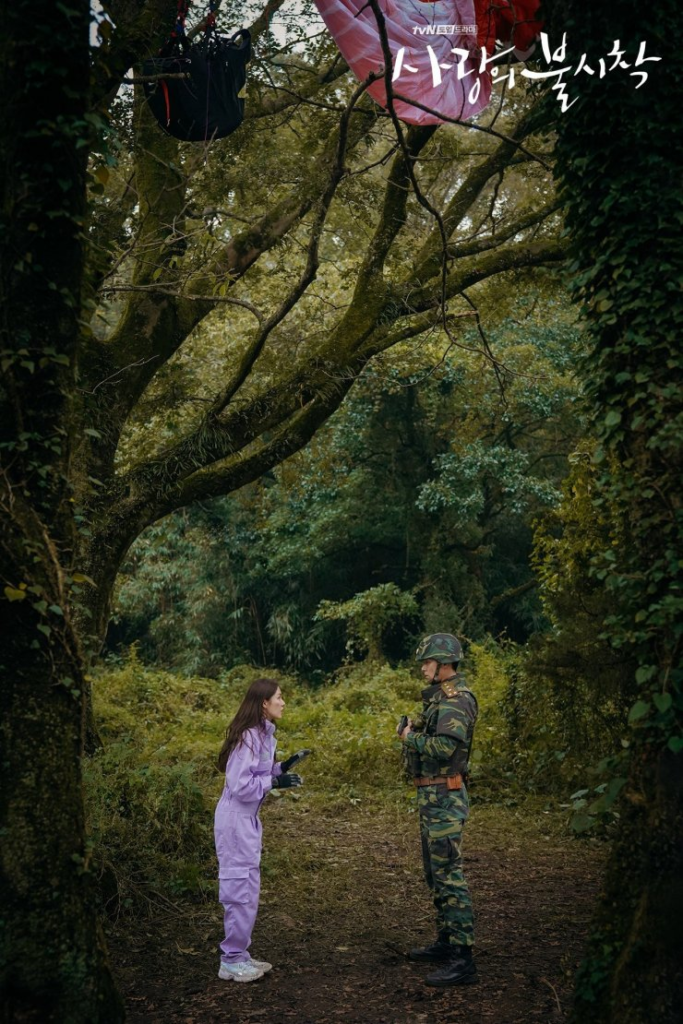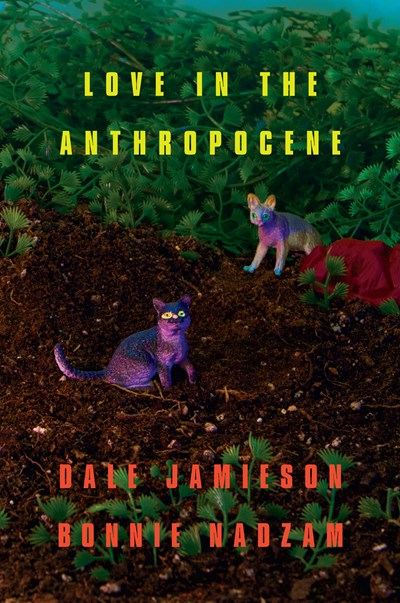This essay was first made available last month, exclusively for our Patreon supporters. If you want to support Full Stop’s original literary criticism, please consider becoming a Patreon supporter.

In the opening episode of 2019 South Korean hit drama series Crash Landing on You (사랑의 불시착), the heiress to a South Korean chaebol (재벌) conglomerate wakes up on the eve of her appointment as CEO dangling from a tree in the Korean demilitarized zone. By a twist of fate, she’s been spat out of a freak, cartoonish tornado that cropped up on a paragliding outing (a preemptive celebration of her promotion) over mountainous Seoul some fifty kilometers from the Korean border. Now, ruffled but still immaculate, suspended in her harness like an infant in a swing, she wonders aloud if she’s in a national park, so pristine is the scenery from her unlikely perch.
It’s as good an entrance as any, and the scene may very well have been filmed in a national park. Before long, Yoon Se-ri (윤새리)—played by the iconic Son Ye-jin (손예진)—comes literally crashing down into the arms of her fated lover, Ri Jeong-hyeok (리정혁), a North Korean army captain played by the also iconic South Korean actor Hyun Bin (현빈). Once in his sights, Ri Jeong-hyeok cannot not shoot—or at least apprehend—Yoon Se-ri without erring from his military protocol to respond aggressively and/or defensively (depending on your perspective) to her presence. On the other hand, she is attractive and cosmopolitan, does not look like a spy or invader in her bright pink paragliding suit. The right move may not be clear, but a wrong one between them could reactivate the war. More dangerously perhaps, and to viewers’ delight, they could fall in love—if, that is, they haven’t already.
Love, a gaping variable here, is allegorically both the forbidden territory and the intrusion. If we entertain its grand entrance, the possibility of love-at-first-sight dramatically stands in for Ri Jeong-hyeok’s shoot-on-sight prerogative. Ri operates most immediately on the recognition of Yoon Se-ri’s possible humanity and arguably the possibility of love for her—in this case acutely heteronormative and romantic—instead of his military instincts to kill her. We soon see, however, that this contemplation of a reality wherein their relationship is possible or actionable (a united Korea) is not so much a definitive epiphany as a kind of subsidiary buffer zone within the DMZ: Whatever feelings their encounter initially kindles, whatever universe it allows them to consider or potentialize, Ri still eventually makes to apprehend her. Fatefully, though, before he can do so, he finds his boot on an unmarked landmine and is suddenly rooted to the spot, giving Yoon Se-ri a chance to make a dash for what she thinks is South Korea but is in fact the Other Korea.
One would imagine that the situation “gets real,” that the stakes are maximized, the moment Yoon Se-ri enters the DMZ’s monitored airspace and becomes a terminable target for either military flanking her. But even in the DMZ, even during her interaction with Ri Jeong-hyeok, she is not quite an invader, a not-quite invader. To Ri, she’s an unreadable intention, as if nondirectional: her origin is undefined, as is her trajectory. Yoon Se-ri herself wakes confused and disoriented, in a fugue state resembling her literally suspended state in the tree. So though the demilitarized zone is militarizable because of her presence, she has not necessarily, just by being there, militarized it—actually, yet. In the DMZ, a perpetual “for now,” Yoon Se-ri is terminable but indeterminate.
It’s not until Yoon misdirects her willfulness and defects the “wrong” way, sprints through a minefield, beating all the odds, scales a conveniently downed section of the barbed wire fence and streaks past a patrol tower manned by an inattentive North Korean conscript (ironically watching a pirated South Korean drama), and eventually reaches a provincial community, that the absurdity of her reality catches up to her. She registers it all at once, and she faints. What makes it click is the signage of expressly “vintage” quality she sees around her, the loudly Communist iconography—a big welcome to one of the foremost dystopias in the contemporary political imaginary. This delayed reaction is significant. By its framing, Yoon Se-ri’s complex status as simultaneous defector, refugee, and unwitting invader does not “get real” until she enters North Korea proper and recognizes that fact. Just as she was presumably unconscious when she entered the DMZ only to wake to her location well within its bounds, she wakes to her reality in North Korea, or to North Korea as a (sur)reality of which she is now part, well into the jurisdiction of that formerly unfathomable beyond.
*
In an essay titled “Coda: Love,” the conclusion to coauthored short story collection Love in the Anthropocene, environmental philosopher Dale Jamieson and writer Bonnie Nadzam develop Iris Murdoch’s notion that “Love is the extremely difficult realization that something other than oneself is real.” In light of this formulation, “The paradox of love,” they write, “emerges in its demand to see the beloved as independently real, yet part of a larger conception of oneself.” In the context of the Anthropocene, which their book concedes as our present reality, this has everything to do with escaping the risk of what they call the “narcissist’s playground”—that is, “a nature that is only the extension of ourselves and our desires, without independent meaning or sustenance.” If a natural world fully independent of man is (or was once, as they suggest) our best shot at that recognition of a beyond-self, “how will love arise in a world without nature as we have known it?” What’s beyond us when every window is a mirror?

Moreover, in this new condition, the object of one’s love might “slip away”—or be discovered to have already slipped away—even if the will to know it remains. Consider, the authors suggest, a love of what constitutes the experience of skiing. One’s agency among the mountain, air, and snow. And imagine now that mountain laced in artificial powder. Were one to ski such a slope, would the love for skiing as one knew it still be there, intact? Or has the object—the beloved as originally determined—disappeared?
Like that original experience or beloved, the DMZ as subject slips away upon direct engagement, almost as if it’s not there to begin with, or like we can only experience it as memory. Insofar as it’s an entity defined by the necessary absence of literal humanity, it ceases, upon entry, to be the subject it was when supposed externally. Step into the DMZ and the war goes live, the dormant erupts. In this sense, it’s only perceivable from beyond itself, obliquely. More significantly, it might only be its actual self beyond the self we know or imagine it to be. For a human to stand in “No Man’s Land,” for example, one nickname for the DMZ, where there is definitionally no man, and say “I am in no man’s land” is distinctly paradoxical. But the paradox, like a false floor, is not fully testable. What makes Yoon Se-ri’s presence in the DMZ interesting is that she makes no such demonstrative claim while she’s there, no overtly ontological or self-identifying statement that would immediately warrant her termination and/or the DMZ’s militarization (which is its technical termination and probably hers). Rather, she aims to “leave no trace,” as it were, actively avoids telling Ri her name or nationality lest she become identifiable beyond the DMZ. She denies, in a sense, her very being there, as if to avoid technical trespass. This refusal to define herself as more than an instance or perfectly anomalous body in space, suspends and contains her in the DMZ’s simultaneous stasis and transience.
Even as Yoon runs out of the DMZ in an effort to defect/re-naturalize, Ri’s platoon members, by then on scene and thoroughly implicated in the situation, flap their arms around and shout after her, emphatically urging her the other way: if she’s going to escape, please do it properly, to the South. Because leaving the DMZ and entering North Korea would—and does—make it “realer” for everyone involved, more complicated and more irrevocable: it more inextricably binds and unifies their fates. Whereas her presence in the DMZ feels hypothetical, as if she is there only merely or only just, once Yoon enters North Korea, she has formally transgressed; she’s confirmed her crime, or at least made it fatally confirmable. Soon located by Ri and his motley crew, who are now invested in her safety if only to save themselves (from execution for their military failure, should it be discovered), she lives in the village under comically lenient house arrest, biding her time. Over the course of numerous attempts to smuggle her discreetly (and safely) back into South Korea, Yoon and Ri deepen their romance. Together, with the platoon, they form a kind of family.
Whether or not it was actually surprising to anyone, it was Big News in South Korea, for fans and critics alike, when the two leads started dating publicly in real life, a year after the series’ release—as if, though both actors are South Korean, it substantiated some kind of longing for the fantasy they projected on screen, proved that something of the Korea inside of dramas was real, or realizable. Or maybe it just extended the performance. In any case, the relational possibilities they signaled on screen and gestured beyond it inscribe and reveal the DMZ’s function as a premise on which visions of peninsular realities ironically depend.
Indeed, the completely accidental, completely fateful, coincidental and absurd nature of Yoon Se-ri’s landing invokes the Korean DMZ’s legacy as an arbitrarily conscribed disaster zone whose bounds are as materially operative as they are politically suppositional: the military demarcation line (MDL), which middles the DMZ like a centerfold, loosely approximates the thirty-eighth parallel north, which roughly divides the peninsula in half, assuming a bird’s-eye-view of a map like the one on which it was first drafted by American soldiers in 1953. The DMZ today is as much a representation of that line and the ideological impetus of its historical moment as the line is a representation of the borderland it referred into being. In other words, the DMZ is as much a divider as it is a marker or symbol of division, as much a military complex as it is a representational one.
*
So, what is the DMZ, really? What is the DMZ in fact? Initiatives like the Real DMZ Project, a contemporary art project founded in Cheorwon County, South Korea with the mission of producing research-driven art on the subject of the DMZ, has been actively curating exhibitions and conversations around that question since 2012. The Project has since established an artist residency in the former propaganda village of Yangji-ri (양지리) and articulated a long-term mission of creating an “open archive” of its multi- and intermedia exhibitions across the humanities and social sciences. But not all such exhibitions are strictly based in Cheorwon, or even in South Korea. The Project has both exhibited internationally—in Europe, North America, and other parts of Asia—and drawn artists from abroad to the Korean border for regional research and productions, a testament to the scope of the project, and to the DMZ’s sprawling domain. How, these experiments ask, do we imagine the DMZ without containing it (further)? And further, how do we imagine it without rendering it completely abstract?
Particularly in light of Don Mee Choi’s book of multimedia poetry DMZ Colony, migration and translation have emerged as two prominent artistic tropes for accessing the forbidden space that is the Korean DMZ. But the tunneling irony of employing these theoretical modes of witness to get “into” an otherwise inaccessible arena is that “the DMZ” has become itself a highly pliable, transferable metaphor to describe conceptual impasses more generally, potentially dislocating it further from any one particular DMZ’s sociopolitical roots. In The Fabric of the Cosmos, for example, theoretical physicist Brian Greene metaphorizes the disciplinary (dis)juncture between quantum mechanics and string theory as a “demilitarized zone.” More interesting than the metaphor of warring factions, though, are the theoretical “realms” that he describes as falling exactly within—as if belonging to—the DMZ’s bounds:
“A very few realms—extreme physical situations that are both massive and tiny—fall squarely in the demilitarized zone, requiring that general relativity and quantum mechanics simultaneously be brought to bear. The center of a black hole, in which an entire star has been crushed by its own weight to a minuscule point, and the big bang, in which the entire observable universe is imagined to have been compressed to a nugget far smaller than a single atom, provide the two most familiar examples.”
If the paradoxical inhabits the DMZ precisely, as Greene suggests in the context of his discourse, the proposition of love as another one of these unreconciled realms is interesting—and appropriate, I propose, in the context of the Korean DMZ—in that it exacerbates the tension it exacts: Love, an enormously evocative and absurdly interpretive trope, only enunciates the chasm between representations of the Korean DMZ as a strictly socio-political subject, and representations of the DMZ as a metaphor or trope in itself. Put differently, the DMZ seems perpetually representationally caught between character and caricature. Love, perhaps the grandest possible proposition of a new reality, even if that reality is metaphorical, when staged in the DMZ, problematizes both types of representations. The appeal to love as a revelatory force—most commonly familial or fraternal, but also hetero-romantic as in Crash Landing on You—is at once a familiar rhetorical strategy for galvanizing peninsular unification platforms and a basic generative paradigm for imagining other worlds emotionally. The contention with either usage is mostly that any particular iteration of love, as Jamieson and Nadzam write in their essay, is seemingly “radically contingent,” or highly specific to the given beloved. You would love your child in any case, but they are a single case. Love, in this view, is both site-specific and totally random, and possibly universal—real and unreal, particular and abstract. A kind of reversal of this irony is that the DMZ makes imaginable not only a Korea without it, but also other Koreas with other DMZs—and, yes, other worlds. For example, a Korean peninsula connected North to South by rail—a vision the current DMZ blockades—gives way to the vision of a Korea connected to Moscow and Europe by rail—that is, to transnational and continental possibilities that intimate alternative Cold War (in)conclusions and the possibility of DMZs elsewhere.[1] To imagine these other DMZs as markers of unlived histories is again, of course, to recognize the simultaneous arbitrariness and profundity of this one.
*
With respect to the Korean peninsula, one such “other DMZ”—perhaps as “real” as any other—appears in the text-based video Miss DMZ by Young-Hae Chang Heavy Industries, an artist duo known for publishing their content online since the early 2000s when the Internet was highly experimental. Today, their works can be found on their website, and have been exhibited at some of the world’s most recognized art spaces, including the Tate and the Whitney. Miss DMZ, in many ways characteristic of the duo’s aesthetics, features a first-person narrator who follows a mysterious flyer into the back of a grocery store, through a long tunnel and into the DMZ. The flyer advertises a duty-free store, ostensibly in the narrator’s neighborhood, Palpan-dong (팔판동), in Seoul (the narrator is ostensibly masculine, based on his later gendered interactions) but what he finds at the end of the tunnel is “what / looks like a large, / warmly-lit lobby / of an old / and grand east- / European hotel” filled with elegantly dressed guests. He is greeted by “a startlingly / pretty woman wearing a / charcoal-gray tailleur,” who is none other than Miss DMZ. She bears across her jacket a sash that reads her name, but that doesn’t stop her from declaring to his face, “I’m Miss / DMZ.”—and further, that—“This is / the DMZ.” To the same borderline-frenetic jazz that backdrops the hypertext of the entire video, the two are said to dance, to gamble at the casino, to get a room. The narrator confesses he has no money, but rest assured, everything’s on the house, is part of Miss DMZ’s totally free, totally exclusive service.
Significantly, the flyer the narrator follows into the store within the DMZ is described as one of many; it’s only unique in that it is the only one the narrator picks up: “…the wind rustles a bunch / of cheap-looking flyers. / I put all but one back in / the display case from which they’ve fallen.” There is, in retrospect, the thought that every flyer enacts a different journey to a different DMZ. The simultaneous ubiquity and uniqueness of the chosen flyer communicates the chance nature of the ensuing escapade. But even more salient is how it again resembles what Jamieson and Nadzam describe as humans’ unique ability to “love the one we’re with.” What begins as an “all but one” exception, a random remainder of a clean-up job, becomes a kind of “one and only,” a deeply particular relational journey. This theme sharpens in the darkness of the tunnel through which the narrator walks for a notably extended period. Sonically and textually, a great deal is happening for us viewers, as one’s eyes remain busy second to second. But in the narrator’s diegetic visuality, only occasional flyers advertising the store are said to punctuate the passage. The signs, featuring hand-drawn arrows are redundant, as the passageway, though it has turns, has no actual forks. Moreover, the journey is characterized as an exercise not of choice or free-will but commitment:
“This posting reappears / several more times, / often at a bend / in the corridor, / not as a direction, / for no confusion / is possible — you advance / or you retreat — / but like a much / needed en-couragement / to / continue.”
The above sentence (the line breaks here signaling panel breaks in the video) is comparatively difficult to follow at the pace it appears in the timed sequence. The use of the archaic for as a because in “for no confusion,” moreover, is markedly confusing, especially ironic because the sentence iterates the impossibility of directional confusion in the journey, the supposed clarity of the narrator’s path or destiny. “Sometimes right,” reads another sequence, “sometimes left, but the arrow pointing in the only possible direction.” This apparent contradiction—the convoluted, oblique signaling of a vector—is certainly meant to express the paradoxicality of the narrator’s entrance and of the space being entered. There’s a classic sense, due to the jerking, erratic textual cues and forward-tending music, that we’re all poised at the edge of our perceptual fields, that we’re going somewhere substantive insofar as we feel the strain of our movement. The vacuous experience of the duty-free store itself, then, and the eerie vapidity of the narrator’s engagement with Miss DMZ undermine this expectation. Indeed, the narrative payoff is oddly absent, but so is the very notion of transaction on which payoff depends.
We might not call this night a night of true love—we might sooner liken it to skiing on fake snow—but who can tell? The experience remains curiously contained and untestable, the relationship unpursuable for the narrator thereafter, stunted. The narrator must leave the DMZ, though he wants to stay forever, because Miss DMZ informs him that his time is up. When he attempts to return the next day, he of course finds the tunnel gone, an empty storage room in its stead. The flyers are also nowhere to be seen. His night with Miss DMZ becomes a floating feature in a so-called global neutral space, at once iconic, singular, random, and abstract.
[1] There are, indeed, other demilitarized zones in existence today—the border between Kuwait and Iraq, for instance, and The Green Line in Cyprus—and more still if we count lapsed DMZs like Vietnam’s. Antarctica, moreover, and to the extent that the 1967 Outer Space Treaty provides, Outer Space itself, is technically demilitarized.
Jed Munson is a Fulbright scholar to South Korea. His chapbook, Newsflash Under Fire, Over the Shoulder, is forthcoming with Ugly Duckling Presse.
This post may contain affiliate links.







